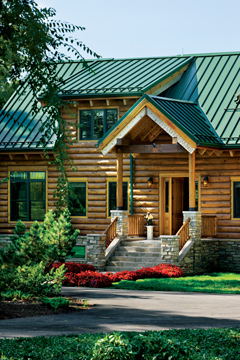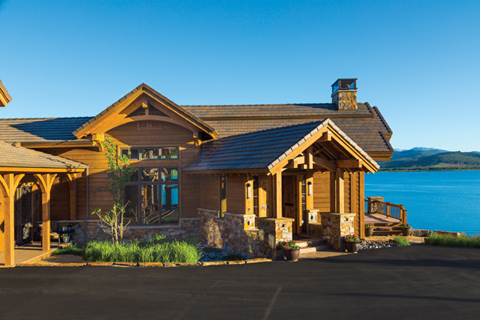Modern construction materials and methods complement the rustic charm and appeal of log and timber homes, allowing owners to complete their project with the aesthetics they want with lasting, good-looking components. One of the most visible and structurally significant elements of a new home is the roof.
The choices for roofing material are extensive, and two factors—location and climate—significantly influence the decision. “What really is going to matter is the type of weather where you are,” explains Gabe Butler, owner of Montana Log Homes. “We had 87 inches of snow one weekend here in Steamboat Springs, Colorado, and that is a lot more than some areas.”
Butler advises that 50-year architectural grade asphalt shingles make an excellent choice, while metal is a good alternative depending on the design of the roof. Those that are divided or cut up with numerous valleys and dormers are not the best candidates for metal. Another issue with metal roofs relates directly to weather patterns. With a rapid temperature increase, a metal roof may release a load of snow suddenly, creating a structural hazard for load-bearing exterior elements such as decks or potential injury to anyone walking below the edge of the roof.
“Metal does hold up well in high winds because it is screwed down,” Butler adds. “Full-length panels are also resistant to leaking, especially if you use a full ice and water shield membrane. Metal also has fireproof aspects.”
At Honest Abe Log Homes, roofing packages are completed through the felt stage, and then customers are advised to choose exterior roofing locally. Design and Drafting Manager Fred Kendall sees a trend toward standing seam metal roofs.
“Traditional metal roofs, while less expensive, do not have the quality and durability of standing seam metal,” comments Beasley. “Color fastness has been an issue in the past, and we recommend that the consumer do research prior to purchasing to ensure that the product they are looking at does not have a tendency to fade dramatically. Hail damage can be an issue, but metal is typically more durable than traditional shingles.”

Expedition Log Homes & RJ Daily Construction / photo by Roger Wade
Nate Hayon, a log home specialist for Expedition Log Homes, agrees that the influences of location and climate weigh heavily on a roofing decision for a log or timber frame home. “The best roofing options depend on where the home will be built and the complexity of the roof structure,” he says. “If the home is located in a warmer, heavily wooded, or heavy snow area, I would suggest a simple roof structure and metal. The reasons would be longevity from heat, tree debris, and snow shed, and ease of installation. In an area that is cooler with moderate tree cover and snowfall and a complex roof system, asphalt shingles will have an extended life.”
From an aesthetic standpoint, the beauty of cedar shakes is difficult to beat, while quality asphalt shingles complement just about any exterior.
“Asphalt shingles in 30- or 50-year grade are extremely popular,” advises Butler. “They are available in so many colors, and you can get blended colors that go well with log or timber frame homes. I love cedar shakes, but they are so expensive, especially if they are certified for fire resistance, and in a lot of counties that is the only way they will let you use cedar shakes. In the climate we have in Steamboat Springs, though, they don’t last very long. Ice will creep underneath and pop them loose.”
Ceramic, slate and faux slate, concrete, clay, and fiberglass shingles are a few other options for roofing materials, and more are on the way. Each has its own cost-benefit attributes, and ease of installation is an important factor to consider.
“We recently attended the International Builders Show, and there were a number of exhibitors with new roofing options,” relates Kendall. “One company was making a composite shake from 95 percent recycled post-industrial plastics. That product has a lifetime warranty, which is a huge benefit over a true cedar shake. Another company was making a tile that had a polystyrene foam core with an outer shell of concrete or fiberglass. Of course, these products have not been on the market long and tend to be much more expensive than their traditional counterparts. There is a lot of innovation coming from the roofing industry.”
Exploring options, doing research, and considering external influences will lead to the best choice for a long-lasting roof that adds to the enjoyment of a log or timber frame home for many years.

